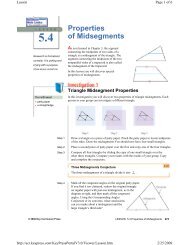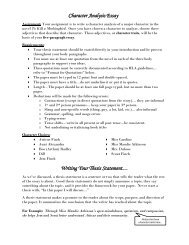Medieval Europe and the Ottoman Empire - Redmond School District
Medieval Europe and the Ottoman Empire - Redmond School District
Medieval Europe and the Ottoman Empire - Redmond School District
Create successful ePaper yourself
Turn your PDF publications into a flip-book with our unique Google optimized e-Paper software.
The Hundred Years’ War<br />
ESSENTIAL QUESTION Who fought in <strong>the</strong> Hundred Years’ War?<br />
In <strong>the</strong> 1300s, Engl<strong>and</strong> <strong>and</strong> France faced not only <strong>the</strong> plague but<br />
frequent warfare as well. Between 1337 <strong>and</strong> 1453, Engl<strong>and</strong> <strong>and</strong> France<br />
fought each o<strong>the</strong>r in <strong>the</strong> Hundred Years’ War War. It was actually a series of<br />
wars—not one continuous battle.<br />
Background for <strong>the</strong> War William, Duke of Norm<strong>and</strong>y, was<br />
from <strong>the</strong> Norman region of France. He claimed to be <strong>the</strong> rightful<br />
king of Engl<strong>and</strong>. In 1066, William captured Engl<strong>and</strong> in what is called<br />
<strong>the</strong> Norman invasion. He became known as William <strong>the</strong> Conqueror<br />
<strong>and</strong> tied <strong>the</strong> nobility of France with <strong>the</strong> nobility of Engl<strong>and</strong>. Over <strong>the</strong><br />
years, tensions grew over who had <strong>the</strong> right to rule ei<strong>the</strong>r region.<br />
Years of Battle Those tensions reached a crisis point in <strong>the</strong> early<br />
1300s. Engl<strong>and</strong> claimed territory in <strong>the</strong> southwest of France. France<br />
was supporting Scotl<strong>and</strong>’s fight against Engl<strong>and</strong>. There was also debate<br />
about rights to sea travel in <strong>the</strong> English Channel. Fighting began when<br />
<strong>the</strong> king of France tried to take <strong>the</strong> territory claimed by Engl<strong>and</strong> in<br />
sou<strong>the</strong>rn France. The English king responded by claiming that he was<br />
<strong>the</strong> rightful king of France. In 1337, Engl<strong>and</strong> attacked France.<br />
The English had several victories. In 1428, <strong>the</strong> English attacked<br />
Orleans, one of France’s last major strongholds. A French peasant girl<br />
known as Joan of Arc led <strong>the</strong> French to victory. By 1453, <strong>the</strong> French<br />
had driven <strong>the</strong> English from France <strong>and</strong> ended <strong>the</strong> war.<br />
Joan of Arc (c. 1412–1431)<br />
Joan of Arc was born a peasant in Domrémy, France,<br />
around 1412. She was a devoted Catholic. When she was<br />
about 13, she believed that religious visions were urging<br />
her to fight <strong>the</strong> English during <strong>the</strong> Hundred Years’ War. In<br />
1429, she went to Charles, <strong>the</strong> French heir to <strong>the</strong> throne.<br />
Charles often prayed alone, but Joan knew what he said.<br />
Convinced her visions were divine, Charles made her a<br />
knight. In May 1429, Joan led <strong>the</strong> French to victory in <strong>the</strong><br />
battle against <strong>the</strong> English at Orleans.<br />
A year after <strong>the</strong> victory at Orleans, Joan was captured<br />
by allies of Engl<strong>and</strong>. She was eventually executed in<br />
1431. She became a national heroine in France <strong>and</strong> was<br />
declared a saint by <strong>the</strong> Catholic Church in 1920.<br />
335








